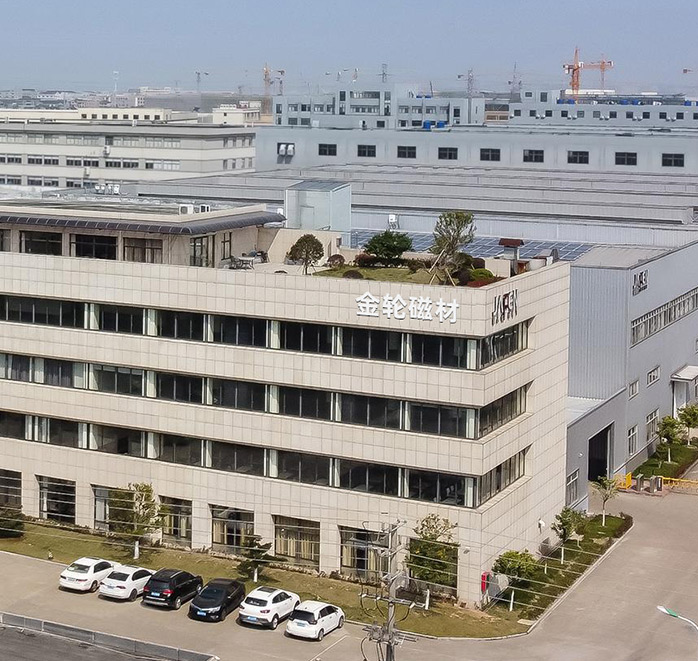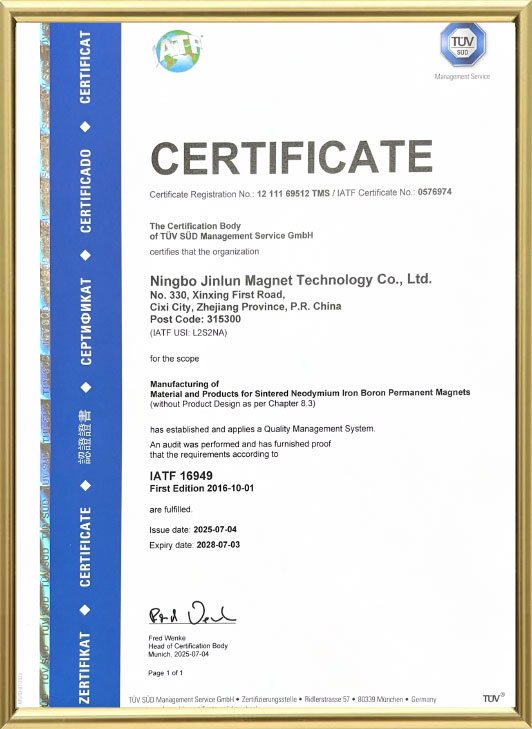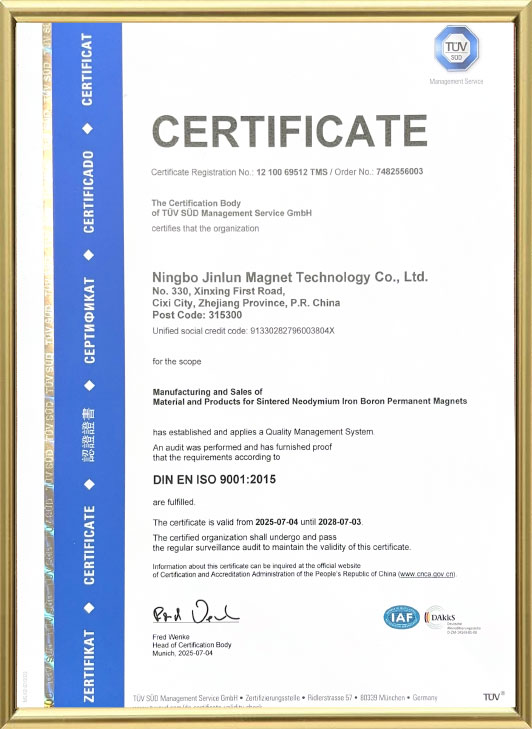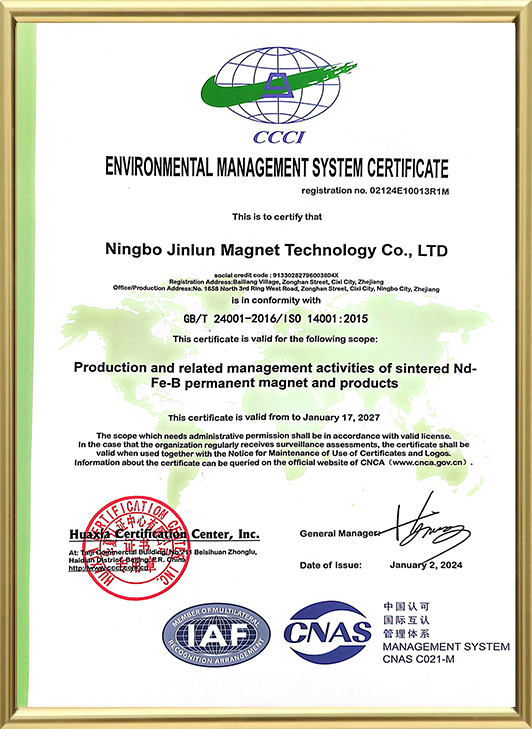I. Basic Understanding of Ring Sintered NdFeB
(I) Definition and Material Composition
Ring sintered NdFeB, or ring-sintered NdFeB, is a high-performance permanent magnet primarily composed of the rare earth elements neodymium (Nd), iron (Fe), and boron (B). Its primary chemical composition is Nd₂Fe₁₄B, with neodymium playing a key role in enhancing the magnet's coercivity and remanence. Iron, as a matrix element, imparts excellent magnetic conductivity. Boron contributes to the formation of a stable crystal structure and is crucial for optimizing the magnet's magnetic properties. In addition to these three primary elements, trace elements such as cobalt (Co), dysprosium (Dy), terbium (Tb), aluminum (Al), and copper (Cu) are added in appropriate amounts to meet the specific performance requirements of different applications. For example, adding cobalt can increase the Curie temperature of a magnet, enhancing its magnetic stability in high-temperature environments. Heavy rare earth elements such as dysprosium and terbium can significantly increase the coercivity of a magnet, making it less susceptible to demagnetization under harsh conditions such as strong magnetic fields or high temperatures.
(II) Production Process Overview
Alloy Melting: Raw materials containing neodymium, iron, boron, and other additive elements are placed in a vacuum induction melting furnace or arc melting furnace according to precise stoichiometric ratios. Melting is performed under a vacuum or inert gas (such as argon) to prevent oxidation of the raw materials at high temperatures and ensure uniform mixing of the elements, resulting in a uniform alloy ingot. This process places strict demands on parameters such as temperature, melting time, and stirring speed, which directly impact the uniformity of the alloy composition and subsequent magnet performance.
Hydrogen Crushing (HD): This utilizes the property of rare earth metals (such as NdFeB alloys) that their crystal lattice expands and becomes brittle when hydrogen is absorbed. The melted alloy ingot is placed in a hydrogen-filled atmosphere, where it absorbs the hydrogen and is crushed into millimeter-sized coarse powder. This step not only efficiently crushes the alloy but also refines the grains to a certain extent, facilitating subsequent magnetic property enhancement. The crushed coarse powder must be stored in a sealed, oxygen-free environment to prevent oxidation.
Jet milling: The coarse powder after hydrogen crushing is fed into a jet mill. Driven by a high-speed jet of high-pressure gas (such as nitrogen), the coarse powder particles collide and rub against each other, further refining the powder size to the micron level, resulting in NdFeB fine powder that meets molding requirements. Similarly, the fine powder must be properly stored in an oxygen-free, sealed container to prevent oxidation and deterioration of magnetic properties.
Molding: Under a nitrogen atmosphere, the NdFeB fine powder is filled into a specially designed annular mold. A strong external magnetic field (such as a pulsed or rotating magnetic field) is applied to orient the powder particles in a specific direction. Mechanical pressure (such as with a hydraulic press) is then applied to form the green compact with a preliminary shape and a certain density. Factors such as magnetic field intensity, orientation time, pressing pressure, and pressing speed significantly influence the green compact's magnetic orientation, density, and dimensional accuracy. Sintering and Heat Treatment: The ring-shaped green body is placed in a vacuum sintering furnace and sintered at temperatures between 1000 and 1200°C. The high temperature promotes atomic diffusion between the powder particles, forming a strong metallurgical bond, significantly increasing the density and mechanical strength of the magnet, while also enhancing its magnetic properties. After sintering, aging treatment (a low-temperature heat treatment process) is typically required. By precisely controlling the temperature and time, the magnet's microstructure is adjusted to further optimize key magnetic properties such as remanence, coercivity, and maximum magnetic energy product.
Machining: Although the sintered ring magnet blank possesses the basic magnetic properties and shape, its dimensional accuracy and surface quality often fall short of meeting practical application requirements. Various machining methods are required, such as wire cutting for inner and outer diameters, slicing to control ring thickness, centerless grinding and double-sided grinding to improve surface flatness and finish, and drilling or trepanning for specialized mounting holes. These methods are used to transform the blank into a finished ring magnet with precise dimensions and satisfactory surface quality. Ningbo Jinlun Magnet Technology Co., Ltd., a leading domestic manufacturer of sintered NdFeB magnets, leverages over 30 years of industry experience and utilizes state-of-the-art permanent magnet production and processing equipment. This allows for precise control of machining accuracy and ensures that magnet dimensional tolerances meet the requirements of high-end applications.
Surface Treatment: NdFeB magnets are chemically active and susceptible to oxidation and corrosion in air, which reduces magnetic performance and service life. Therefore, surface protection treatment is required. Common treatment methods include electroplating (such as zinc, nickel, and copper plating), chemical plating (such as chemical nickel plating), electrophoretic coating (such as electrophoretic epoxy), and spray coating (such as zinc-aluminum spray coating). Different surface treatment processes have their own advantages and disadvantages in terms of protection, cost, and appearance. The appropriate choice should be made based on the specific environment and performance requirements of the magnet. Testing and Magnetization: Using professional magnetic testing equipment (such as gaussmeters, fluxmeters, and hysteresis loop meters), we accurately measure key magnetic parameters of ring magnets, such as remanence (Br), coercive force (Hc), and maximum magnetic energy product (BHmax), to ensure product quality standards. Furthermore, based on the specific magnetic field direction and distribution requirements of the application scenario, magnetizers are used to magnetize the magnets, imparting specific magnetic field directions and intensities. Common magnetization directions include axial magnetization (magnetic field direction perpendicular to the upper and lower surfaces of the ring), radial magnetization (magnetic field direction along the ring radius), and multi-pole magnetization (forming multiple magnetic poles around the ring circumference). Ningbo Jinlun Magnetics, a modern, integrated enterprise integrating innovative R&D and manufacturing, rigorously controls product quality during testing to ensure that each batch of ring magnets meets performance standards and provides customers with high-quality products.
II. Ring Sintered NdFeB Performance Characteristics
(I) High Magnetic Properties
High remanence (Br): Remanence refers to the magnetic flux density retained after a magnet reaches saturation magnetization and the external magnetic field is removed. Ring sintered NdFeB magnets have high remanence, typically reaching 1.0-1.4 Tesla (Tesla), with some high-performance products exceeding 1.4 Tesla. For example, in electric vehicle drive motors, high remanence enables the motor rotor to generate a stronger magnetic field. When interacting with the stator windings, it can output greater torque, directly improving the motor's power and efficiency, meeting the electric vehicle's demand for efficient power output.
High coercivity (Hc): Coercivity reflects a magnet's ability to resist interference from an external reverse magnetic field and maintain its inherent magnetic properties. NdFeB ring magnets have a high coercivity, typically ranging from 800-2000 kA/m. Wind turbines operate in complex environments and may be exposed to unstable external magnetic fields. High-coercivity ring-shaped NdFeB magnets ensure magnetic stability under various operating conditions, maintaining stable generator operation and safeguarding power generation efficiency and quality.
High magnetic energy product (BHmax): The magnetic energy product describes the amount of magnetic energy stored and available per unit volume. Ring-shaped sintered NdFeB magnets have a high BHmax, typically ranging from 200 to 500 kJ/m³. This superior BHmax allows NdFeB ring magnets to achieve smaller size and lighter weight compared to other permanent magnet materials, while maintaining the same magnetic performance requirements. For example, in small portable electronic devices (such as mobile phone vibration motors and wireless headphones), NdFeB ring magnets can provide a sufficiently strong magnetic field within limited space while meeting the demands of miniaturization and lightweight design. Ningbo Jinlun Magnetics specializes in the production of high-performance magnets. Its ring-shaped sintered NdFeB magnets excel in core performance indicators such as high magnetic energy product, making them suitable for a wide range of applications requiring stringent magnetic properties.
(II) Excellent Mechanical Properties
High Hardness: After sintering and other processes, ring-shaped NdFeB magnets possess a high hardness, typically ranging from 5 to 6 on the Mohs scale, approaching the hardness of steel. This makes them less susceptible to scratches and wear when subjected to certain levels of external friction and impact. This maintains the magnet's dimensional accuracy and surface quality, ensuring long-term stable operation in complex mechanical environments. For example, in motors used in industrial automation equipment, the magnetic ring rotates at high speeds along with the motor rotor. High hardness ensures that the ring's surface does not degrade, potentially impacting motor performance, even under long-term high-speed operation and mechanical vibration.
Sufficient Strength: Although NdFeB magnets are inherently brittle, through appropriate composition design and process control, they possess a certain degree of compressive and flexural strength, enabling them to withstand moderate mechanical stress. During motor assembly, the magnetic ring needs to be installed onto the rotor or stator. This process may involve a certain degree of squeezing and hammering. Its inherent strength ensures that it will not crack or damage under normal assembly stress, ensuring smooth motor assembly.
(III) Dimensional Accuracy and Stability
High-precision dimensions: Utilizing advanced mold manufacturing technology, precision molding processes, and precise machining methods, ring-shaped sintered NdFeB magnets achieve high dimensional accuracy. Common dimensional tolerances include outer diameter tolerances of ±0.03 - ±0.05mm, inner diameter tolerances of ±0.04 - ±0.05mm, and height tolerances of ±0.06 - ±0.1mm. In electronic devices such as hard disk drives, which require extremely high component dimensional accuracy, high-precision NdFeB ring magnets precisely match other components, ensuring stable operation and enabling high-speed, accurate data reading and writing. Ningbo Jinlun Magnetics, leveraging internationally advanced production equipment and mature processes, can consistently produce ring magnets with the required dimensional accuracy to meet the assembly requirements of high-end electronic devices like hard disk drives. Good shape stability: During the production process, strict control of process parameters effectively ensures the shape stability of the magnetic ring. Even under environmental factors such as high temperature and high humidity, the size and shape of the magnetic ring change minimally, maintaining a stable magnetic field environment and mechanical properties. For example, the NdFeB rings used in sensors within the engine compartment of a car maintain precise magnetic field output despite large temperature fluctuations and high humidity within the engine compartment, thanks to their excellent shape stability, ensuring the sensor can stably detect engine operating parameters.
III. Applications of Ring Sintered NdFeB
(I) Motors
Electric Vehicle Drive Motors: The drive motor is a core component of electric vehicles. Ring sintered NdFeB magnets are used in motor rotors. Their high magnetic properties enable the motor to achieve high power density, delivering powerful power in a compact size and weight, effectively improving the acceleration performance and driving range of electric vehicles. Furthermore, their excellent temperature stability ensures efficient and stable operation under various operating conditions and ambient temperatures, meeting the complex driving requirements of electric vehicles.
Wind Turbines: Ring NdFeB magnets are commonly used in the permanent magnet synchronous generators of wind turbines. Its high remanence and coercive force enable the generator to start and generate electricity efficiently even at low wind speeds, improving wind energy utilization. Furthermore, the magnet's stable performance in complex outdoor environments (such as high and low temperatures, dust, and humidity) ensures reliable operation and continuous power output of the wind turbine.
Industrial Automation Motors: Industrial automation production lines, such as robot joint drive motors and CNC machine tool spindle motors, place extremely high demands on motor precision, response speed, and stability. Ring NdFeB magnets help motors achieve high speed and high-precision control, ensuring smooth operation and precise positioning, improving industrial production efficiency and product quality. Ningbo Jinlun Magnet Technology Co., Ltd., a professional manufacturer of sintered NdFeB magnets, produces high-performance ring magnets that are widely used in industrial automation motors, supporting high-precision operation.
(II) Electronic Equipment
Hard Disk Drives (HDDs): Ring NdFeB magnets are used in the voice coil motors (VCMs) in HDDs. The precise and stable magnetic field generated by the magnetic ring enables fast and accurate control of the magnetic head's position on the disk, enabling high-speed data read and write operations and meeting the large-capacity, high-speed demands of modern data storage.
Mobile Phone Vibration Motors: The linear motors or eccentric rotary motors in mobile phones often utilize ring-shaped NdFeB magnets. By controlling the electromagnetic interaction between the magnet and the coil, precise and rapid vibration feedback is generated, providing users with a rich and delicate tactile experience, such as realistic vibration feedback during typing or gaming on a mobile phone.
Wireless Headphones: The speaker units of wireless headphones utilize ring-shaped NdFeB magnets. Their high magnetic properties enable the speakers to efficiently convert electrical signals into sound signals, delivering clear, rich sound quality. Furthermore, the miniaturization and lightweight nature of the magnetic rings meet the compact and lightweight requirements of wireless headphones.
(III) Sensor Field
Position Sensors: In automotive electronics, industrial automation, and other fields, position sensors employ ring-shaped sintered NdFeB magnets in conjunction with Hall effect elements. The magnetic field changes generated by the magnetic ring can be precisely detected by Hall elements and converted into electrical signals, which can be used to accurately measure parameters such as an object's position, speed, and angle. For example, in a car's electronic power steering (EPS), the position sensor uses the magnetic ring to monitor the steering angle in real time, providing precise steering assistance.
Current Sensors: Current sensors based on the magnetic balance principle often use ring-shaped NdFeB magnets. When the measured current passes through the coil, it generates a magnetic field that interacts with the magnetic field of the magnetic ring. By detecting the changes in the magnetic field, the current can be accurately measured. In smart grids, new energy vehicle charging facilities, and other fields, the magnetic rings in current sensors ensure accurate current monitoring and control, ensuring stable operation of the power system.
(IV) Other Fields
Medical Devices: In magnetic resonance imaging (MRI) equipment, ring-shaped NdFeB magnets are used to generate a high-intensity, highly uniform static magnetic field, providing the basic conditions for imaging, helping doctors clearly observe internal tissue structures and assist in disease diagnosis. In addition, ring-shaped NdFeB magnets may also be used in some small wearable medical devices (such as heart rate sensors in smart bracelets), leveraging their magnetic field properties to monitor human physiological parameters.
Magnetic transmission devices: In applications requiring contactless power transmission, such as sealed pipeline transportation systems in the chemical and food industries, magnetic couplers composed of ring-shaped NdFeB magnets are used. This achieves contactless power transmission through magnetic field interaction, eliminating the risk of leakage caused by poor sealing in traditional mechanical transmissions. It also reduces mechanical wear and improves system reliability and lifespan. Ningbo Jinlun Magnet Technology Co., Ltd. continuously innovates. Its ring-shaped sintered NdFeB magnets, with their stable performance, are also suitable for specialized applications such as magnetic transmission devices, providing customers with competitive product solutions.
 EN
EN English
English 中文简体
中文简体 русский
русский Deutsch
Deutsch 日本語
日本語 한국어
한국어

























